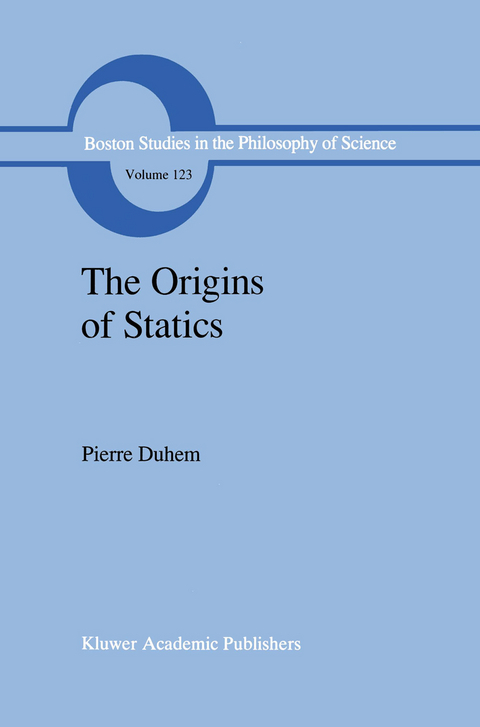
The Origins of Statics
Springer (Verlag)
978-94-010-5658-8 (ISBN)
Preface.- I. Aristotle (384–322 B.C.) and Archimedes (287–212 B.C.).- II. Leonardo da Vinci (1452–1519).- III. Jerome Cardan (1501–1576).- IV. The Impossibility of Perpetual Motion.- V. The Alexandrian Sources of Medieval Statics.- 1. The works attributed to Euclid.- 2. The Liber Charastonis, published by Thâbit ibn Qurra.- 3. The treatise De canonio.- VI. Statics During the Middle Ages — Jordanus de Nemore.- 1. What do we know about Jordanus de Nemore?.- 2. Some passages from Aristotle’s Mechanical Problems.- 3. The Elements of Jordanus on the Demonstration of Weights.- VII. The Statics of the Middle Ages (Continued) — The School of Jordanus.- 1. The Genesis of the Liber Euclidis de ponderibus.- 2. The Peripatetic transformation of the Elementa Jordani.- 3. The Precursor of Leonardo da Vinci. Discovery of the concept of moment. Solution to the problem of the inclined plane.- 4. The Treatise on Weights according to Master Blasius of Parma.- VIII. The Statics of the Middle Ages and Leonardo da Vinci.- 1. The School of Jordanus, the Treatise of Blasius of Parma and the Statics of Leonardo da Vinci.- 2. The Composition of Forces.- 3. The Problem of the Inclined Plane.- IX. The School of Jordanus in the 16th Century — Nicolo Tartaglia.- 1. Nicolo Tartaglia or Tartalea.- 2. Jerome Cardan. — Alexander Piccolomini. —.- X. The Reaction Against Jordanus — Guido Ubaldo — G.B. Benedetti.- 1. Guido Ubaldo, Marquis del Monte (1545–1607).- 2. Giovanbattista Benedetti (1530–1590).- XI. Galileo Galilei (1564–1642)..- XII. Simon Stevin (1548–1620)..- XIII. The French Contribution to Statics — Roberval.- 1. Salomon de Caus. The Early Works of F. Mersenne. The Course on Mathematics by Pierre Hérigone.- 2. Gilles Persone de Roberval (1602–1675).- XIV.The French Contribution to Statics (Continued) — René Descartes (1596–1650).- Preface.- XV. The Mechanical Properties of the Center of Gravity from Albert of Saxony to Evangelista Torricelli.- First Period —From Albert of Saxony to the Copernican Revolution.- Second Period — From the Copernician Revolution to Torricelli.- XVI. The Doctrine of Albert of Saxony and the Geostaticians.- 1. How the notion of the center of gravity was refined. The influence of Kepler.- 2. How the notion of the center of gravity was refined (continued). The geostaticians.- XVII. The Systematization of the Laws of Statics.- 1. F. Marin Mersenne (1588–1648), Blaise Pascal (1623–1662), F. Zucchi (1586–1670), F. Honoré Fabri (1606–1688).- 2. The Traité de Méchanique of Roberval.- 3. John Wallis (1616–1703).- 4. The great treatises of statics from the Jesuit school. F. Dechales (1621–1678), F. Paolo Casati (1617–1707).- 5. The reaction against the methods of virtual velocities and virtual work; Jacques Rohault (1620–1675), F. Pardies (1636–1673). The Treatises of F. Lamy, The De motu animalium of Borelli.- 6. The Parallelogram of Forces and Dynamics. The Observations of Roberval. Varignon (1654–1722). The Letter of F. Lamy. The Principia of Newton. The Neo-Statics of F. Saccheri.- 7. The Letter of Jean Bernoulli to Varignon (1717). The definitive formulation of the Principle of Virtual Displacements.- Note A. On the Identity of Charistion and Heriston.- Note B. Jordanus de Nemore and Roger Bacon.- Note C. On the Various Axioms Permitting the Deduction of the Theory of the Lever.
| Reihe/Serie | Boston Studies in the Philosophy of Science ; 123 |
|---|---|
| Übersetzer | G.F. Leneaux, V.N. Vagliente, G.H. Wagener |
| Zusatzinfo | XXXV, 596 p. |
| Verlagsort | Dordrecht |
| Sprache | englisch |
| Maße | 155 x 235 mm |
| Themenwelt | Geisteswissenschaften ► Geschichte |
| Geisteswissenschaften ► Philosophie | |
| Naturwissenschaften ► Physik / Astronomie ► Mechanik | |
| Sozialwissenschaften ► Politik / Verwaltung ► Politische Theorie | |
| ISBN-10 | 94-010-5658-7 / 9401056587 |
| ISBN-13 | 978-94-010-5658-8 / 9789401056588 |
| Zustand | Neuware |
| Haben Sie eine Frage zum Produkt? |
aus dem Bereich


